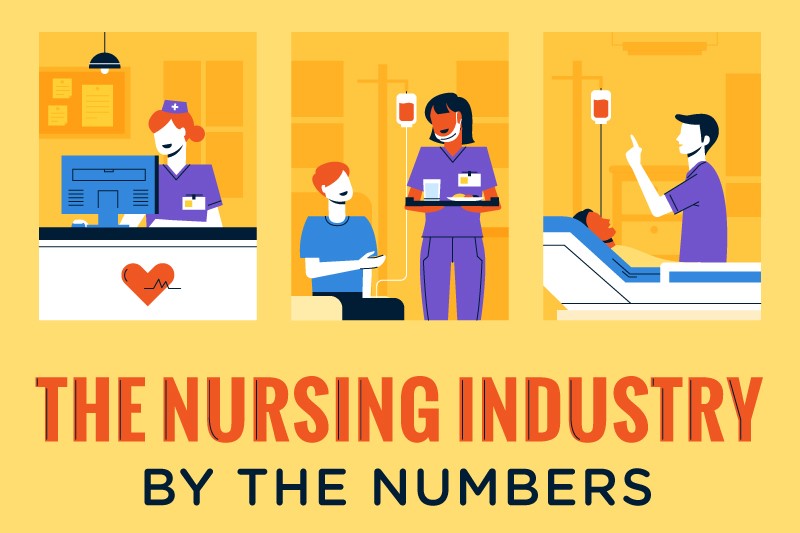[vc_row][vc_column][vc_column_text]The latest healthcare and nursing statistics all confirm that this is the fastest-growing and arguably most rewarding industry out there, known for its capability to constantly evolve to provide the highest possible care for patients all over the world.
If you’re dreaming of becoming a nurse one day, then it’s crucial to educate yourself on everything there is to know about the industry you’ll be entering.
Luckily, this article contains the most important information and research everyone should be aware of, so relax and keep on reading.
10 Key Nursing Statistics to Keep in Mind
- According to recent developments, there will be a 12% growth in the employment of registered nurses from 2018 to 2028.
- 86% of the nurses in the Americas, 84% of the nurses in Europe, and 79% of those in Southeast Asia are females.
- 9% of registered nurses identify as African American (non-Hispanic) or black.
- Some of the slightly less fun nursing facts on wage disparity note that male nurses in the US make $6,000 more than female nurses.
- It’s predicted that trauma nursing employment will grow at the fast rate of 16% up through 2024.
- 50% of nurses could not fully agree that their leaders and supervisors supported and encouraged the development of their careers.
- Some interesting facts about nursing show that 68% of nurses claim that their careers would benefit from national licensing.
- There are almost 3 million registered nurses in the United States.
- The demand for registered nurses will increase by 19% between 2012 and 2022.
- According to recent data from 2019, the job growth for certified nursing assistants will be 21% by the year 2022.
Check out the data we collected and illustrated in the infographic for a fuller understanding of this dynamic industry.[/vc_column_text][/vc_column][/vc_row][vc_row][vc_column][vc_single_image source=”external_link” external_img_size=”800×12390″ alignment=”center” custom_src=”https://healthcareers.co/wp-content/uploads/2020/01/The-Nursing-Industry-by-the-Numbers-Infographic.jpg”][/vc_column][/vc_row][vc_row][vc_column][vc_column_text]
The Global Nursing Facts and Figures
1. Midwives and nurses make up half of all health workers worldwide.
(WHO)
There are 43.5 million workers in the health industry, of which 20.7 million are midwives and nurses.
However, the numbers show that only 50% of the World Health Organization’s Member States claim to have no more than 3 midwifery and nursing employees per 1000 members of the population.
2. Belgium has one of the highest demands for nurses, at 18%.
(University–Zamosc)
Nursing statistics up through 2017 show that the demand for nurses increased by a surprising 26% over a two-year period based on the number of online job postings.
The lack of skilled nursing employees was most noticeable in European countries, such as Germany, where there were around 35,000 job openings.
An increase in demand has also been noticed in Great Britain (17.2%) and Holland (16.9%).
3. In 2018, the UK’s Nursing and Midwifery Council register counted a total of 690,278 midwives and nurses.
(NMC)
According to 2018’s numbers on the future of nursing practice in the United Kingdom, there were 495 fewer midwives and nurses on the register at the end of March 2017.
Nevertheless, the numbers between March 2017 and 2018 show that the total midwives and nurses in the UK increased by 1,321, and the number of midwives and nurses outside the EEA increased by 1,093.
4. In 2017, there were approximately 59,000 full-time midwives and nurses working in Scotland, according to the National Health Service.
(NHS Scotland)
According to recent nursing trends in Scotland, midwifery and nursing represent the largest employee group within the health workforce, having accounted for an overall total of 42.6% of the staff members.
Furthermore, the numbers from September 2017 show that there was an increase of 0.4% since the previous year. Since 2012, there was a 5.6% increase in rates.
5. It’s believed that 400,000 midwives and registered nurses work in Australia.
(James Cook)
The demand rates for midwives and registered nurses in some countries are insane, which is only confirmed by our facts about being a nurse in Australia.
Generally, the highest demand is for senior nurse leaders. They’re the most treasured due to their role in steering, retaining, and motivating the existing nursing workforce.
6. 86% of the nurses in the Americas, 84% of the nurses in Europe, and 79% of those in Southeast Asia are female.
(WHO)
Women rule the industry, which becomes abundantly clear when comparing the number of women vs. men in nursing, statistics show.
Among the 234 million workers in the social and health sector, women make up 70% of the employees overall. Furthermore, every year, women add $3 trillion to the health industry on a global scale.
7. Switzerland has the most nursing graduates a year, with an estimated 101 per 100,000 citizens.
(OECD)
We’ve seen many nursing industry statistics claiming that the employees in nursing are typically baby-boomers—who are approaching retirement.
As a result, the investment in nursing education for upcoming generations is becoming more and more talked about.
The countries with the most nursing graduates include Korea, Australia, Norway, and Slovenia.
8. The Czech Republic has the fewest nursing graduates, with 14.10 per 100,000 citizens.
(OECD)
According to the current nursing trends from 2018, many of the countries belonging to the Organization for Economic Cooperation and Development have attempted to take measures to expand the number of gifted students in education programs on nursing.
However, on the other end of the spectrum is the Czech Republic, followed by countries such as Mexico, Greece, Turkey, and Luxembourg.
Statistics on the US Nursing Industry
9. There are almost 3 million registered nurses in the United States.
(Minority Nurse)
Furthermore, the latest numbers show that 690,038 licensed practical nurses are working in the US. On average, an RN makes $68,000 a year, and an LPN makes $42,000.
10. Only 9.1% of registered nurses are men, and only 7.6% of licensed practical nurses are men.
(Online Nursing, Minority Nurse)
As previously mentioned, there are significantly fewer men in the nursing field than women, mainly because of the nature of the job.
According to the nursing facts from 2019, 70% of male nurses believe that stereotypes are their greatest obstacle at work.
For example, some believe that male nurses serve only as the “muscle” for their female counterparts, such as mopping floors or lifting patients.
Another misconception is that men aren’t capable of being nurturing and caring.
11. The average age of a licensed practical nurse in the US is 43.
(Minority Nurse)
According to the studied nursing trends, 18.3% of licensed practical nurses are 30 years old or younger, and 14.8% of registered Nurses are 30 years old or younger.
12. Of all registered nurses in the US, 9.9% identify as African American (non-Hispanic) or black.
(Minority Nurse, Geriatric Nursing)
Based on the nursing industry facts, the demand for minority nurses continues to rapidly grow, as nursing schools, nursing associations, and hospitals attempt to provide support to minority registered nurses, licensed practical nurses, and nursing students.
The numbers also show that 8.3% identify as Asian, and 4.8% identify as Latino or Hispanic.
13. 69.6% of Asian registered nurses have a bachelor’s degree or higher.
(Minority Nurse)
Based on the facts about nursing related to education, Asians or Pacific Islanders are most likely to have entered the nursing profession with a bachelor’s degree.
Furthermore, the statistics show that 14.6% of African American or black nurses have a master’s or a doctoral degree, compared to 13.4% of white nurses.
14. Male nurses in the US make $6,000 more than female nurses.
(Healthcare IT)
Based on some interesting nursing facts related to the salary disparities between male and female nurses, the numbers show that men make more money than women. In fact, the average salary for men is $79,688, while women make $73,090.
One of the reasons for this may be that men are more likely to negotiate their paychecks than women.
15. The state of California has the highest employment level in this industry, with 294,510 nursing positions.
(Drexel)
Based on the nursing facts from 2018, the top five states that display the highest rates of employment for nurses also include Texas (207,810), New York (180,730), Florida (174,710), and Pennsylvania (139,480).
Also, California takes the top spot once more when the annual mean wage is considered: the numbers show that it adds up to $101,850.
16. The average salary for a military nurse in Alaska is 26% lower than the average military nurse salary nationwide.
(Nurse Journal)
One of the perhaps less fun facts about military nurses and their total income shows that the average salary in Alaska for this position ranks 48th in the US.
The salary in Alaska adds up to a total of $41,000, whereas the highest is actually Washington DC, at $68,000.
17. It’s predicted that trauma nursing employment will grow at a fast rate of 16% through 2024.
(Nurse)
Here are some jaw-dropping facts about trauma nurses: It’s believed that trauma nursing employment will grow at a much quicker rate than the average for all nursing jobs!
The statistics show that there’s a major shortage of trauma nurses, as the baby boomer generation is nearing retirement and the health needs of the world are growing as the population ages.
18. A flight nurse’s salary is anywhere between $50,161 and $95,605.
(Registered Nursing)
The job of a flight nurse is demanding but also highly rewarding. According to these fun facts about flight nurses, the median yearly salary for this nursing position is $68,050.
Naturally, the precise amount depends on the candidate’s experience level, the type of employer, and the location.
However, in general, there isn’t an enormous amount of turnover in this kind of position.
Statistics on Job Satisfaction
19. More leaders are needed in the nursing industry, as confirmed by 82% of nurses.
(AMN)
In fact, these nursing shortage statistics show that only a mere 5% of nurses actually disagree with this evaluation.
However, more than half of the nurses, 61% to be exact, wouldn’t want to step into the position of leader, whereas 17% claim that they already are in this position.
20. 50% of nurses either disagreed or were uncertain when asked if their leaders encouraged the development of their careers.
(AMN)
Among many other roles, nurse leaders deploy effective motivational strategies designed to help trainees and other nurses feel empowered.
According to nursing statistics, half of the nurses surveyed strongly disagreed or were hesitant when asked if they would ever trust their leaders.
Thus, the results of the survey confirm that a disconnect between the nursing workforce and its leadership exists.
21. 68% of nurses claim that their careers would benefit from the implementation of national licensing.
(AMN)
According to information on certain trends in nursing from 2017, more than half of registered nurses would prefer national licensing, and 77% of millennial nurses would like to have this available.
On the other side of the spectrum, 48% of nurses claim that they aren’t interested in pursuing further education—a slight rise compared to 2015’s 43%.
Furthermore, a mere 23% of millennial nurses claim that they aren’t interested in further education.
22. According to the nursing shortage statistics from 2017, 52% of nurses claim that these shortages are worse at the moment than they were 5 years ago.
(SIA)
This fairly recent data is a concern, especially when compared to a mere 37% saying the same in 2015.
On the other hand, in 2017, 22% of nurses claimed that nursing shortages aren’t as awful as they were five years ago.
Still, further statistics show that 44% of nursing staff are thinking of quitting their jobs.
23. Nursing statistics show that 73% of the nurses who are near retirement will in fact retire within the next 3 years.
(AMN)
Retirement among older nurses will eventually lead to critical shortages in the workforce. Based on a 2015 study by the National Council of State Boards of Nursing, 50% of registered nurses are over the age of 50.
In addition, 46% of these older nurses will retire within the next four years (or more), and 27% of older nurses will likely retire in less than a year.
Nursing Trends for 2019 and the Future
24. The demand for registered nurses in hospitals will increase by an amazing 36% between 2017 and 2020.
(Host Healthcare)
There will be a greater need for registered nurses than the supply, meaning that potential applicants will have an easier time finding work and receiving a satisfactory salary.
Based on estimated numbers, it’s believed that the number of registered nurses will expand to 3.24 million by the year 2022 (a 19% increase from 2012’s numbers).
25. According to the current nursing trends from 2019, the job growth for certified nursing assistants will be 21% by the year 2022.
(Hospital Jobs)
In case you might be wondering, certified nursing assistants are in a position that delivers direct care to patients.
This impressive percentage means that there will be around 321,200 more job positions in the following years. CNAs receive an average salary of $24,400 a year.
26. Based on future nursing trends and concepts, it’s believed that the nursing care facilities market segment will gain an impressive $126.1 billion in global yearly sales by 2022.
(BusinessWire)
In 2018, the global nursing care market, which includes the care facilities segment, reached almost $855.9 billion, successfully growing at a compound yearly growth rate of 6.8% for the last five years.
Furthermore, it’s believed that nursing care will continue to grow by 8.6% by 2022, reaching $1.19 trillion.
27. Following recent nursing developments, it looks like there will be a 12% growth in the employment of registered nurses between 2018 and 2028.
(BLS)
It’s estimated that the growth in employment rates of registered nurses will be much more rapid than the average rate for all professions.
There are many reasons for this rise, such as the growing number of chronic illnesses and the older population’s increased need for healthcare services.
FAQ
How do you define nursing?
Nursing is briefly defined as the collaborative or autonomous care of people of all backgrounds, ages, communities, and groups, whether they’re healthy or sick. Furthermore, nursing involves the prevention of different illnesses, the promotion of optimal health, and the care of disabled, dying, or ill individuals. Other vital nursing roles include the promotion of a secure environment, as well as taking part in shaping health policy, advocacy, and education.
What kind of nurses are there?
There are plenty of nursing jobs out there for individuals who are interested in the field. The most common types include the following:
- Registered nurses
- Licensed practical nurses
- Travel nurses
- Home health nurses
- Nurse practitioners
- ICU registered nurses
- Medical-surgical nurses
- Nursing assistants
- Telemetry nurses
- Dialysis nurses
- Pediatric nurses
- Labor and delivery nurses
- Cardiovascular nurses
- Radiology nurses
- School nurses
- Oncology nurses
Why are nurses so important?
Nurses are extremely important in healthcare, and some even consider them the most trusted professionals in the industry. Since they spend a lot of time with patients (sometimes 24/7!), they’re able to directly transform lives for the better. Nurses are advocates, critical thinkers, innovators, and most importantly, caregivers. Many would even agree that nurses are the most vital part of the healthcare system.
What do you do as a nurse?
The job of a nurse is extremely demanding, but it’s rewarding at the same time. The following includes the most important daily duties of a nurse:
- Managing intravenous lines
- Caring for and supporting patients
- Dispensing medications to patients
- Consulting with doctors
- Educating the public and patients on managing illnesses, medical conditions, and nutritional plans
- Noticing and recording patients’ conditions
What are the challenges in nursing?
As previously mentioned, nursing positions can be extremely demanding. These are some of the most frequent issues nurses face:
- The fluctuation of salaries, due to regional differences and differences between genders
- Workplace violence, either from coworkers or patients
- Issues of short staffing
- Long work hours, in shifts
- Workplace hazards like injuries, dermatitis due to constant hand washing, and exposure to germs and viruses
Who was the first nurse?
According to nursing history, this was Florence Nightingale, a renowned statistician, social reformer, and the founder of modern nursing. Nightingale rose to prominence while she was a trainer and manager of nurses during the period of the Crimean War, in which she diligently cared for injured soldiers. Furthermore, by writing the very first textbook on nursing (entitled Notes of Nursing), Nightingale effectively established nursing education in 1860.
What is a robotic nurse?
Robotic nurses are simply robots that assist patients in moving around a medical facility, while also potentially helping with the delivery of medicine or checking vital signs. There are also robotic nurses that are used as interfaces for professionals to communicate with patients over distances. Unfortunately, a fully independent robot nurse still doesn’t exist, both because of ethical issues and issues with the system.
What are the recent trends in nursing?
As technology develops and the nursing profession evolves at a rapid pace, so do the trends in the industry. Some of the most prominent trends are considered multifactorial, such as a transition to informatics, the increase in the aging population, nursing shortages, and the integration of practices based on evidence. The transition to informatics is especially helpful in assisting medical facilities in providing more accurate, accessible, and streamlined health histories.
How will technology change nursing in the future?
Some of the latest advances in the industry include 3D printers, artificial intelligence, health-monitoring applications, telemedicine, and electronic health records. It’s believed that technology will change nursing in the following ways:
- By making the job of nurses easier and less physically demanding
- By bringing telemedicine to isolated communities
- By helping draw blood
- By allowing diagnostics to be portable
- And, to complete our list of nursing in the future, by implementing digital pills and chatbots that will help manage medication better
Conclusion
The healthcare industry is an extremely demanding one to step into. At the same time, it’s also highly rewarding.
There are more than twenty different nursing positions, each of which comes with specific duties, requirements, and benefits.
All in all, hopefully the information in this article has helped shine light on one of the most popular and challenging professions in existence.
If you find these nursing statistics interesting, remember to share it with your family members, friends, and colleagues!
Sources:
- AMN Healthcare
- Becker’s Hospital Review
- Britannica
- Bureau of Labor Statistics
- BusinessWire
- Drexel University
- Geriatric Nursing
- Healthcare IT News
- Hospital Jobs Online
- Host Healthcare
- International Council of Nurses
- James Cook University Australia
- Minority Nurse
- NHS Scotland
- Nurse.org
- Nurse.org
- Nurse Journal
- Nursing & Midwifery Council
- Nurse Practitioner School
- Online Nursing MS Degrees
- Organisation for Economic Co-operation and Development
- Rasmussen College
- Registered Nursing
- Sharecare
- Staffing Industry Analysts
- Stanford.edu
- Study.com
- The Medical Futurist
- University of Management and Administration–Zamosc
- World Health Organization
- World Health Organization
[/vc_column_text][/vc_column][/vc_row]



